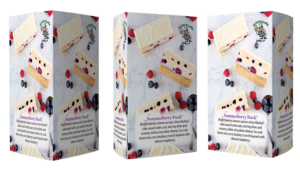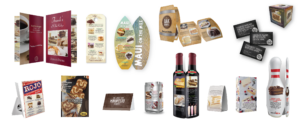Your most valuable piece of marketing as a restaurant owner is a thoughtfully designed menu. It advertises your offerings while increasing your restaurant’s profitability. Menu engineering is the strategic process of designing a menu to maximize profits. It requires analyzing profitable and your most popular menu items. Using menu psychology techniques to highlight these items, restaurants can construct menus in the most effective way.
First, you must analyze menu items to find the most popular and profitable, which is important since you’ll be constructing your menu around these items. Ensure that your menu is priced correctly for maximum profits and understand item popularity using the menu matrix. After analyzing your menu items and pricing them appropriately, the fun can begin with these designing hacks.
Scannability
The first component to consider in menu design is its scannability. Therefore, restaurateurs want to grab guests’ attention with their high profit items. The research shows that customers are likely to order one of the first items that draw their attention. Since guests only spend an average of 109 seconds looking at your menu, it must be designed for guests to easily find key items aka scannable.
You want to avoid crowded layouts, limit item choices, and create a natural flow. Do you ever get overwhelmed at the sight of too many options? This is the psychological theory known as the “paradox of choice,” which assumes that the more options we have, the more anxiety we feel, whereas too little options make consumers feel misrepresented. The golden number for food options is 7 per category. Anything over seven items can ambush customers and lead to confusion, and confusion can cause them to revert to their “usual” by default instead of trying a new menu item. There is no shame in sticking with what you know, but a well-designed menu will entice you to try something different or more expensive.
- Limit Options.Psychologists suggest that restaurateurs limit options per category to the golden number, around 7 items, based on the theory, “paradox of choice”. Limiting options can increase perceptions that consumers made the right choice, which in turn brings customers back. in an industry where repeat customers account for about 70% of sales, getting diners to return is the ultimate goal. (Mental Floss)
- Declutter. Avoid crowded layouts and choose easy-to-read fonts and font sizes. Stick with visible dish titles and clear sections.
- Location, location, location! Psychologists have studied consumer eye patterns and found that our eyes tend to move to the center of the menu first, then move on to the top right corner, followed by the top left corner. This is known as “The Golden Triangle”. Place your most profitable menu items in these prime real estate locations (Webstaurant)
- Use glossaries if needed. Some patrons may feel intimidated by unfamiliar names and be deterred from ordering fancy-sounding dishes. A glossary can give more context so guests feel confident that they’re making an informed decision and the right choice.
Sensibility
Next, consider the menu’s ability to tap into the customer’s senses. Do the food items catch your eye? Does the menu evoke emotion? According to restaurant consultant Aaron Allen, colors can conjure different types of feelings and “motivate” behavior. For example; blue has a calming effect, while red can stimulate appetite and a sense of urgency, and yellow draws our attention. Entertain the use of borders, shaded boxes, and white space to highlight specific and profitable items. Crowding your menu with photos can cheapen the feel of a menu, but a nice-looking picture alongside a food item can increase sales by 30%.
Another tactic is writing longer, more detailed descriptions that persuade customers they are getting more for their dollar. According to a Cornell study, researchers found that more detailed descriptions sold nearly 30% more food. Customers also rated those items as tasting better. “People taste what you tell them they’re tasting” says menu engineer, Gregg Rapp (Mental Floss). So tell them a story! Detail dishes with verbiage that describes where it’s sourced and how it’s prepared to be effective in increasing the perception of quality in the items.
- Use color. Choose a color scheme that reflects your sales and
 marketing objective. People emotionally respond to color, subconsciously, which can influence their behavior. You can use bright colors, which capture attention and trigger appetite, to draw focus to specific arrears of your menu.
marketing objective. People emotionally respond to color, subconsciously, which can influence their behavior. You can use bright colors, which capture attention and trigger appetite, to draw focus to specific arrears of your menu. - Use photos. Use professional photography in your menu, but do it sparingly. People respond to images on display like they would if the plate was right in front of them and if you’re hungry the response is “I’ll have that!”
- It’s all about semantics! Mind the language that you use to describe your dishes and tell a story. Adjectives like “line-caught,” “farm-raised,” or “locally-sourced” are big turn-ons for customers and can increase the perception of quality.
- Make it nostalgic. Touching past time-periods can trigger happy memories of their childhood, family or traditions. “Grandma’s Chicken Soup” or “Campfire Hot Cocoa” stir feelings of comfort and closeness.
Another trick is to create space around high-profit items by putting them in boxes or otherwise separating them from the rest of the options. “When you put in a pocket of negative space, you pull the eye there,” writes Allen. “Putting negative space around an item can call attention to it and help you sell it” (Mental Floss).
Profitability
Finally, circle back to your menu’s profitability. Perspective is everything when considering menu design. Author of Priceless, William Poundstone, reveals the psychology behind menus, stating ”ultimately, it’s about minimizing the focus on price”. Making price tags as inconspicuous as possible, we can encourage guests to spend more. A Cornell University study found that written-out prices also encourage guests to spend more. Here’s a few more hacks that are designed to increase your menu’s profit potential.
- Avoid dollar signs. Currency indicators are a pain point that remind customers they are spending money and make them feel like they are spending more than they actually are. Soften the price by eliminating the dollar sign.
- Avoid price trails. Price trails are dotted lines that connect your menu items to their price and are the cardinal sin of menu design. This takes the focus away from your dish description and straight to the price instead. Try “nested” pricing, prices that are listed discreetly after the meal description in the same font size, so consumer eyes glide right over it (Mental Floss).
- Avoid price columns. Placing prices in a column will draw focus to the cost of the food, instead of the dish itself, which could lead guests to choose the cheapest items on the menu.
- Use price decoys. A price “decoy” is a menu item that would seem overly expensive to guests, placed near high profit margin items. This gives the perception, when compared to the decoy, that customers are getting a deal, a “better bang for their buck”.
- Sandwich your menu items. D Studies show that customers tend to notice and order the top two items or the last item of each section more often than other items. Place your most profitable items at the top of the list and one at the bottom to optimize your menu categories.
Final thoughts
Guests will scan your menu in less than 2 minutes on average, which means you have a small window to set the menu’s tone for customer satisfaction and optimal profit. Using these psychological tactics of menu design, to revamp your menu can greatly improve your restaurant’s profits and guest experience. Our Sweet Street Design Suite provides you with the expertise and tools to sell more.
Sources: Aaron Allen | WebstauranteStore | Canva | Mental Floss | The Sydney Morning Herald



thanks for sharing this post.
Thanks for this good post.